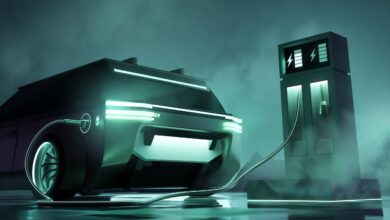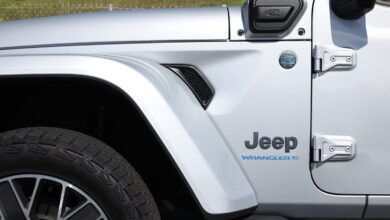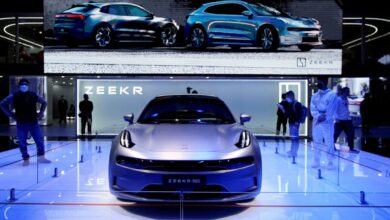2024 Porsche Macan EV Doesn’t Rely on Acceleration Alone

Porsche’s second electric car is aimed squarely at the jugular of the market. Be it affordable or luxurious, the compact SUV is stealing hearts and stealing sales from every vehicle segment. Since everyone seems to want to park one in their garage, it makes sense that Porsche’s second electric offering is a version of its compact SUV, the Macan. Product planners are probably still kicking themselves for sending out the Taycan as the leadoff hitter.
Unimpressed with some of the decisions that were handed down on the shared platform of the original Macan—the height of the front seats for one—Porsche claims to have led the engineering and design of the hardware for the new electric Macan’s Premium Platform Electric (PPE) architecture. This is the sort of decision-making power that comes from having sold more than 850,000 Macans over the past 10 years. Porsche probably could have sold even more, but the Macan’s factory in Leipzig, Germany, has been banging against its three-shift redline for years.
While we never found much wrong with the seating position of the gas-powered Macan, the electric versions, the Macan 4 and the Macan Turbo, sit 1.1 inches lower in front and 0.6 inch lower in the rear seat. Anyone familiar with the gas-powered Macan is unlikely to notice the seating-position difference, but they will likely suspect that they’re in an updated Macan. The gauge cluster is now a 12.6-inch screen, and there’s a 10.9-inch touchscreen in the middle of the instrument panel. For those who want more screens, another 10.9-inch unit in front of the passenger is a $1570 option that will keep your shotgun rider entertained if not carsick. As with all of these passenger-facing screens, the driver’s view of it is blacked out when the Macan is out of park, making it impossible to watch “Window Shop with Car and Driver” on YouTube while driving.
There’s a simplicity to the rest of the interior, but, thankfully, a volume knob remains and there are physical HVAC controls below the touchscreen. The leather-wrapped dashboard is a rich touch, but the plainness of the design doesn’t look expensive, a view perhaps made worse by the black interior of our sample cars. A 3.4-inch wheelbase increase over the old Macan doesn’t add up to a vastly larger interior here. Rear-seat room is spacious enough for a six-footer and certainly won’t trigger claustrophobics, but the rear seat isn’t a cross-your-legs situation if you sit behind an average driver. Just like on a 911, there’s a front trunk (or frunk). There’s only three cubic feet of space up there, but it checks an electric-car box that the Germans had largely ignored. Most of your stuff will go under the hatch, where there’s up to 18 cubic feet of space.
Some electric-car facts: The new platform has a 95.0-kWh battery pack living under the floor and provides a Car and Driver–estimated 250 to 300 miles of range. Like the Taycan, the electric Macan has an 800-volt architecture that enables fast-charging. Porsche says it’ll run from 10 to 80 percent charge in the time it takes to watch an episode of Seinfeld without commercials—actually, Porsche said about 21 minutes. On a slower AC connection, the onboard charger can take in as much as 11.0 kW, so figure on about 10 hours from empty to full.
Those numbers out of the way, let’s discuss what a Macan without an engine is like to drive. First off, it’s quiet. The Macan 4 and the Macan Turbo we drove both were fitted with optional thermal and acoustic glass ($920), which helped keep sound levels low. For $490, you can select Electric Sport Sound, which offers a louder buzzy, wooshy soundtrack for the driving experience. We tried it, started to get a headache, took a couple of Advil, then switched it off. Save your money.
Both the 402-hp Macan 4 and the Turbo share their 234-hp front motors. While the 4 gets by with a 375-hp rear motor, the Turbo’s rear unit cranks out 630 horsepower. Getting maximum power from either requires engaging launch control, which can be done only from a stop. Do so and you get 10 seconds of overboost. In normal driving, the 4 makes 382 horsepower with Turbo making 576 horses.
Instant torque—479 lb-ft in the 4 and 811 in the Turbo—gives an immediate response to the slap of the accelerator, but the 4 doesn’t impress off the line. Porsche says the 4 is a good for a 4.9-second time to 60 mph, and in a world of very quick EVs, that doesn’t feel very quick. The Turbo will snap necks with a claimed 3.1-second 60-mph time.
Electric cars that accelerate as hard as sports cars or even supercars aren’t surprising anymore. What the Macan does that few, if any, other battery-powered SUVs can do is handle. Bend it into a corner, and, despite a curb weight on the wrong side of 5000 pounds, the 5.5-inch-lower center of gravity helps mitigate the mass.
Both models have eager steering (electric Macans have a 15 percent quicker steering ratio) with natural weighting, and both try their best to unbend corners. Rear-axle steering is optional on both models, and the system works to stabilize the rear end at speed. At low speeds it cuts the turning circle down to a carlike 36.4 feet. Both the 4 and the Turbo will have active dampers and adjustable air springs as standard. Body control is taut and contributes to the driver’s confidence to push toward the cornering limits. An active rear differential that allows for torque vectoring is standard on the Turbo and optional on the 4.
Ride quality is supple but not cushy. If you’re seeking isolation and a delicate ride, the much-larger BMW i7 will make you smile. If you’re about to comment that the i7 isn’t a direct competitor, well, what is? When it arrives at this fall, the electric Macan won’t face much competition. Mercedes’s EQE SUV perhaps comes closest in size and price, but it seems to have been designed to isolate rather than engage. A Tesla Model Y or even a Model X are the same shape, but again, they lack the driving joy that makes the Macan entertaining. Acura’s ZDX promises to challenge the battery-powered Macan, but we’re still a few weeks away from experiencing it. And then there’s BMW’s new iX3, which is still months away. For the first time, Porsche might find a direct competitor from Hyundai and its 641-hp Ioniq 5 N.
In Europe, the gas-powered Macan will no longer be sold, but U.S. customers will continue to have a choice of gas or electric Macans. The gas-fired ones will continue on the old platform, virtually unchanged. Anyone deciding between the two will look at the prices and notice that the electric Macan appears to command a major premium, but if you compare the Macan 4 to its gas equivalent, the 375-hp Macan S, the difference works out to be $6500. The 630-hp Turbo doesn’t line up with any of the gas versions and would be $18,500 more than the 434-hp V-6-powered GTS. We still love the sound and the experience of accelerating with a gas-engine Macan, but the new Macan works well as an electric. It looks more modern inside and out, and, like the Taycan, the Macan 4 and Turbo have more than just acceleration to make you smile. And that’s rare in today’s electric-car world.
Specifications
Specifications
2024 Macan EV
Vehicle Type: front- and rear-motor, all-wheel-drive, 5-passenger, 4-door wagon
PRICE
Base: Macan 4, $80,450; Macan Turbo, $106,950
POWERTRAIN
Front Motor: permanent-magnet synchronous AC, 234 hp, 229 lb-ft
Rear Motor: permanent-magnet synchronous AC, 375 or 630 hp, 428 or 605 lb-ft
Combined Power: 402 or 630 hp
Combined Torque: 479 or 833 lb-ft
Battery Pack: liquid-cooled lithium-ion, 95.0 kWh
Onboard Charger: 11.0 kW
Peak DC Fast-Charge Rate: 270 kW
Transmissions: direct-drive
DIMENSIONS
Wheelbase: 113.9 in
Length: 188.4 in
Width: 76.3 in
Height: 63.8 in
Cargo Volume, behind F/R: 44–47/16–18 ft3
Front-Trunk Volume: 3 ft3
Curb Weight (C/D est): 5250–5400 lb
PERFORMANCE (C/D EST)
60 mph: 2.9–4.7 sec
100 mph: 10.6–12.4 sec
1/4-Mile: 11.2–13.5 sec
Top Speed: 136–161 mph
EPA FUEL ECONOMY (C/D EST)
Combined: 75–90 MPGe
Range: 250–300 mi
Tony Quiroga is an 18-year-veteran Car and Driver editor, writer, and car reviewer and the 19th editor-in-chief for the magazine since its founding in 1955. He has subscribed to Car and Driver since age six. “Growing up, I read every issue of Car and Driver cover to cover, sometimes three or more times. It’s the place I wanted to work since I could read,” Quiroga says. He moved from Automobile Magazine to an associate editor position at Car and Driver in 2004. Over the years, he has held nearly every editorial position in print and digital, edited several special issues, and also helped produce C/D’s early YouTube efforts. He is also the longest-tenured test driver for Lightning Lap, having lapped Virginia International Raceway’s Grand Course more than 2000 times over 12 years.



